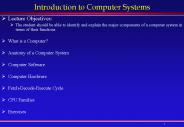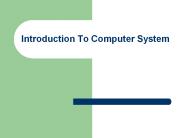Computer Systems - PowerPoint PPT Presentation
1 / 18
Title:
Computer Systems
Description:
A System with Virtual Memory. Address Translation: Hardware converts ... you find yourself complaining about the cramped 64-bit address space in your computer! ... – PowerPoint PPT presentation
Number of Views:47
Avg rating:3.0/5.0
Title: Computer Systems
1
Computer Systems
- Virtual Memory
2
A System with Virtual Memory
Memory
Page Table
Virtual Addresses
Physical Addresses
0
1
P-1
Disk
- Address Translation Hardware converts virtual
addresses to physical addresses via lookup table
(page table)
3
VM advance 1 Caching Tool
- DRAM Cache (Main Memory)
- Each allocated page of virtual memory has entry
in page table - Mapping from virtual pages to physical pages
- From uncached form to cached form
- Page table entry even if page not in memory
- Specifies disk address
Cache
Page Table
Location
0
On Disk
1
4
Locating an Object in a Cache
- SRAM Cache (level 1 en level 2)
- Tag stored with cache line
- Maps from cache block to memory blocks
- From cached to uncached form
- Save a few bits by only storing tag
- No tags for blocks not in cache
- Hardware retrieves information
- can quickly match against multiple tags
5
Memory Mountain
6
Page Faults (like Cache Misses)
- What if an object is on disk rather than in
memory? - Page table entry indicates virtual address not in
memory - OS exception handler invoked to move data from
disk into memory - current process suspends, others can resume
- OS has full control over placement, etc.
Before fault
After fault
Memory
Memory
Page Table
Page Table
Virtual Addresses
Physical Addresses
Virtual Addresses
Physical Addresses
CPU
CPU
Disk
Disk
7
VM Address TranslationHardware vs Software
page fault
fault handler
Processor
?
Hardware Addr Trans Mechanism
Main Memory
Secondary memory
a
a'
OS performs this transfer (only if miss)
physical address
virtual address
part of the on-chip memory mgmt unit (MMU)
8
VM Address Translation
- Parameters
- P 2p page size (bytes).
- N 2n Virtual address limit
- M 2m Physical address limit
n1
0
p1
p
virtual address
virtual page number
page offset
address translation
0
p1
p
m1
physical address
physical page number
page offset
Page offset bits dont change as a result of
translation
9
Address Translation via Page Table
virtual address
page table base register
n1
0
p1
p
virtual page number (VPN)
page offset
VPN acts as table index
physical page number (PPN)
access
valid
PTEA
PTE
if valid0 then page not in memory
0
p1
p
m1
physical page number (PPN)
page offset
physical address
10
Integrating VM and Cache
- Most Caches Physically Addressed
- Allows multiple processes to have blocks in cache
at same time - Cache doesnt need to be concerned with
protection issues (Access rights checked as part
of address translation) - Perform Address Translation Before Cache
- But this involves a memory access itself (of the
PTE) - Of course, page table entries can also become
cached
11
Speeding up Translation with a dedicated cache
- Translation Lookaside Buffer (TLB)
- Small hardware cache in MMU
- Maps virtual page to physical page numbers
- Contains complete PTEs for small number of pages
12
What do you know?
- (ow133)cpuid
- This system has a Genuine Intel(R) Pentium(R) 4
processor - Processor Family F, Extended Family 0, Model
2, Stepping 7 - Pentium 4 core C1 (0.13 micron) core-speed 2 Ghz
- 3.06 GHz (bus-speed 400/533 MHz) - Instruction TLB 4K, 2M or 4M pages, fully
associative, 128 entries - Data TLB 4K or 4M pages, fully associative, 64
entries - 1st-level data cache 8K-bytes, 4-way set
associative, sectored cache, 64-byte line size - No 2nd-level cache or, if processor contains a
valid 2nd-level cache, no3rd-level cache - Trace cache 12K-uops, 8-way set associative
- 2nd-level cache 512K-bytes, 8-way set
associative, sectored cache, 64-byte line size
13
VM advance 2 Memory Management
- Multiple processes in physical memory.
- How do we resolve address conflicts?
- what if two processes access something at the
same address?
memory invisible to user code
kernel virtual memory
stack
esp
Memory mapped region forshared libraries
Linux/x86 process memory image
the brk ptr
runtime heap (via malloc)
uninitialized data (.bss)
initialized data (.data)
program text (.text)
forbidden
0
14
Solution Separate Virt. Addr. Spaces
- Each process has its own virtual address space
- operating system controls how virtual pages as
assigned to physical memory
0
Physical Address Space (DRAM)
Virtual Address Space for Process 1
Address Translation
0
VP 1
PP 2
VP 2
...
N-1
(e.g., read/only library code)
PP 7
Virtual Address Space for Process 2
0
VP 1
PP 10
VP 2
...
M-1
N-1
15
Linux Organizes VM as Collection of Areas
process virtual memory
vm_area_struct
task_struct
mm_struct
vm_end
vm_start
mm
pgd
vm_prot
vm_flags
mmap
shared libraries
vm_next
0x40000000
vm_end
- pgd
- page directory address
- vm_prot
- read/write permissions for this area
- vm_flags
- shared with other processes or private to this
process
vm_start
data
vm_prot
vm_flags
0x0804a020
text
vm_next
vm_end
0x08048000
vm_start
vm_prot
vm_flags
0
vm_next
16
VM advance 3 Protection
- Page table contains access rights information
- hardware enforces this protection (trap into OS
if violation occurs)
Memory
Process i
Process j
17
Linux Page Fault Handling
- Is the VA legal?
- i.e. is it in an area defined by a
vm_area_struct? - if not then signal segmentation violation (e.g.
(1)) - Is the operation legal?
- i.e., can the process read/write this area?
- if not then signal protection violation (e.g.,
(2)) - If OK, handle fault (3)
process virtual memory
vm_area_struct
shared libraries
1
read
3
data
read
2
text
write
0
18
Assignment
- Practice Problem 10.1Find the largest possible
virtual address. - At some point in your lifetime, you find yourself
complaining about the cramped 64-bit address
space in your computer!































